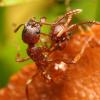I have a Camponotus sp. (I believe she's a Camponotus Herculeanus) queen that recently lost her last worker. I was thinking of trying to introduce her to one of my Camponotus Pennsylvanicus workers from my largest colony.
I have a general idea of how i'd do it, but would like some input to greater the outcome if anyone has experience in this.
Is a queen more likely to accept the worker than the worker is to accept the queen?
Can I lower the workers temps without doing it to the queen, so I don't stress her out more than she already is?
Anyone know the general period of time the worker needs to lose their pheromone trace?

















